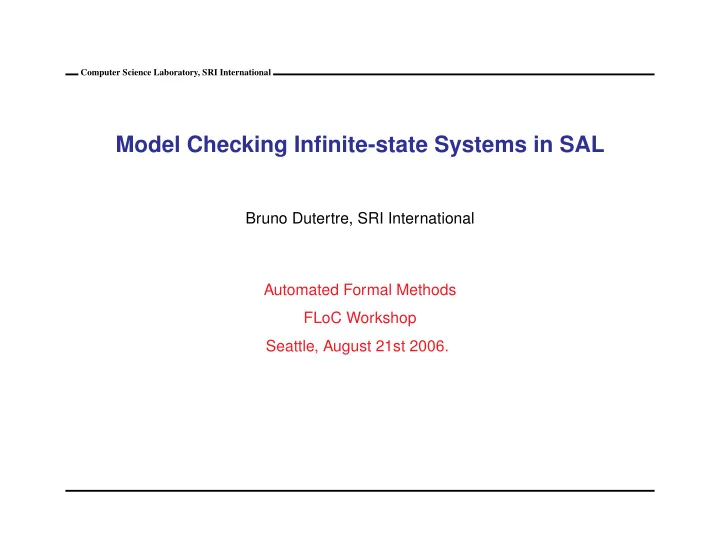

Computer Science Laboratory, SRI International Model Checking Infinite-state Systems in SAL Bruno Dutertre, SRI International Automated Formal Methods FLoC Workshop Seattle, August 21st 2006.
Computer Science Laboratory, SRI International Outline The DRT Example Counter-based Model ◦ SAL model ◦ Property specification ◦ Verification Timeout Automata Model ◦ Definition ◦ Application to DRT References 1
Computer Science Laboratory, SRI International DRT Simplified Delayed Trip Reactor (inspired by Lawford and Zhang, Equivalence Verification of Timed Transition Systems , ACSD 2004) Power = low Wait 2 s Power = high Power = high a c e Pressure = high open Relay Wait 3 s close Relay if Power = low Safety Property: if power and pressure at high at time t , and power is still high at t + 30 then the relay must be open for at least 20 time units, starting at some time in [ t + 30 , t + 31] . (time unit is 0 . 1 s) 2
Computer Science Laboratory, SRI International Counter-Based Model Need: model real-time delays Approach: ◦ Discrete time and synchronouus composition ◦ One transition = one discrete time step = one time unit ◦ Integer-valued counters to model delays ◦ Finite model if all delays are bounded. 3
Computer Science Laboratory, SRI International Application to DRT Controller Model Safety Property ◦ Specifying the property ◦ Analysis: smc, bmc, inf-bmc A Weaker Property Variant ◦ Reactor model and verification 4
Computer Science Laboratory, SRI International k -induction To show that a transition system M = ( X, I, T ) satisfies ✷ P Usual induction ◦ Base case: I ( x ) ⇒ P ( x ) ◦ Induction step: P ( x ) ∧ T ( x, x ′ ) ⇒ P ( x ′ ) k -induction ◦ Base case: I ( x 0 ) ∧ T ( x 0 , x 1 ) ∧ . . . ∧ T ( x k − 2 , x k − 1 ) ⇒ P ( x 0 ) ∧ . . . ∧ P ( x k − 1 ) ◦ Induction step: P ( x 0 ) ∧ T ( x 0 , x 1 ) ∧ . . . ∧ T ( x k − 2 , x k − 1 ) ∧ P ( x k − 1 ) ∧ T ( x k − 1 , x k ) ⇒ P ( x k ) Usual induction is k -induction with k = 1 Proving ✷ P by k -induction is the same as proving ✷ ( P ∧ ◦ P ∧ . . . ∧ ◦ k − 1 P ) by induction 5
Computer Science Laboratory, SRI International Limits of Counter Models Expressiveness ◦ Not applicable to dense time Verification Issues ◦ Lots of intermediate states where nothing happens (just counters get increased or decreased) ◦ BMC or induction depth depends on constants in the model (large depth for simple system may make SMC or BMC blow up) 6
Computer Science Laboratory, SRI International Timeout-Based Model State variables ◦ global time t and timeouts τ 1 , . . . , τ n (real-valued) ◦ discrete variables τ i stores a time in the future, where a discrete transition is scheduled to happen t � τ i is an invariant Discrete Transitions ◦ Enabled when t = τ i for some i ◦ Do not change t and must update τ i to a value larger than t Time-progress transitions ◦ Enabled when t < min( τ 1 , . . . , τ n ) ◦ Increase t to min( τ 1 , . . . , τ n ) 7
Computer Science Laboratory, SRI International Application to DRT SAL Model ◦ Controller ◦ Reactor ◦ Clock Verification ◦ BMC: search for counterexamples ◦ k -induction: proof ◦ discovering auxiliary lemmas 8
Computer Science Laboratory, SRI International To Get More Information SAL and Yices ◦ http://sal.csl.sri.com & http://sal-wiki.csl.sri.com ◦ http://yices.csl.sri.com & http://yices-wiki.csl.sri.com Infinite & Timed Systems in SAL ◦ B. Dutertre and M. Sorea, Modeling and Verification of a Fault-Tolerant Real-time Startup Protocol using Calendar Automata , FORMATS/FTRTFT 2004 ( http://www.csl.sri.com/ ∼ bruno/publis/startup.pdf ) ◦ B. Dutertre and M. Sorea, Timed Systems in SAL , Technical Report, SRI-SDL-04-03, July 2004. ( http://www.csl.sri.com/ ∼ bruno/publis/sri-sdl-04-03.pdf ) ◦ L. Pike and S. Johnson, The Formal Verificaiton of a Reintegration Protocol , EMSOFT’05, ( http://www.cs.indiana.edu/ ∼ lepike/pub pages/emsoft.html ) ◦ G. Brown and L. Pike. Easy parameterized verification of biphase and 8N1 protocols , TACAS’06, ( http://www.cs.indiana.edu/ ∼ lepike/pub pages/bmp.html ) ◦ G. Brown and L. Pike. “Easy” parameterized verification of cross clock domain protocol , DCC’06, ( http://www.cs.indiana.edu/ ∼ lepike/pub pages/dcc.html ) 9
Recommend
More recommend